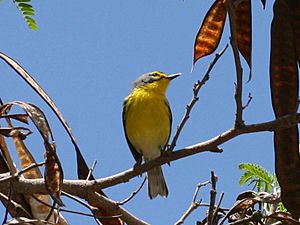Adelaide's warbler facts for kids
Quick facts for kids Adelaide's warbler |
|
|---|---|
 |
|
| Conservation status | |
| Scientific classification | |
| Synonyms | |
|
Dendroica adelaidae Baird, 1865 |
Adelaide's warbler (Setophaga adelaidae) is a small, colorful bird. It lives only in Puerto Rico, which is an archipelago (a group of islands). This bird is part of a group called Setophaga in the Parulidae family. It got its name from Adelaide Swift. Her father, Robert Swift, found the very first one.
Contents
About Adelaide's Warbler
Adelaide's warbler has gray feathers on its back and yellow feathers underneath. It has a bright yellow stripe above its eye. There is also a white half-moon shape just below its eye. This bird is about 12 centimeters (4.7 inches) long. It weighs around 7 grams (0.25 ounces).
Where Does it Live?
Adelaide's warbler lives on the main island of Puerto Rico. It also lives on the nearby island of Vieques. These birds prefer dry forests in the southern part of Puerto Rico. You can find them in places like the Guánica State Forest. Some also live in the wetter moist forests in the north. They can also be found in the central mountain range, called Cordillera Central.
What Does it Eat?
Adelaide's warbler is an insectivore, meaning it mainly eats insects. It finds its food by gleaning. This means it picks insects off leaves and branches. It usually searches in the middle and top parts of the forest. Sometimes, though rarely, it also eats spiders. It might even eat tiny amphibians like coquís (small frogs).
How Does it Behave?
These warblers often travel in groups with other types of birds. These are called mixed flocks. They often join Puerto Rican todies, vireos, and other New World warblers.
Nesting and Eggs
Adelaide's warblers build their nests in trees. They place their nests between 1 and 7 meters (3 to 23 feet) off the ground. The female bird lays 2 to 4 white eggs. These eggs usually have small brown spots on them.
How Scientists Classify This Bird
For a long time, scientists thought Adelaide's warbler was part of a larger group. This group included similar birds from Barbuda and St. Lucia. They were all considered one species with different types, called subspecies.
Later, scientists decided these birds were different enough. So, the birds from Barbuda became the Barbuda warbler. The birds from St. Lucia became the St. Lucia warbler. And the bird from Puerto Rico became Adelaide's warbler. Each is now its own species.
In 2011, bird experts changed how they grouped many warblers. Adelaide's warbler was moved into the Setophaga group. This shows how science keeps learning and updating information!
See also
 In Spanish: Reinita puertorriqueña para niños
In Spanish: Reinita puertorriqueña para niños


